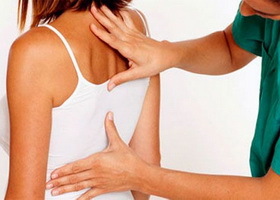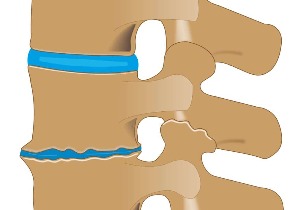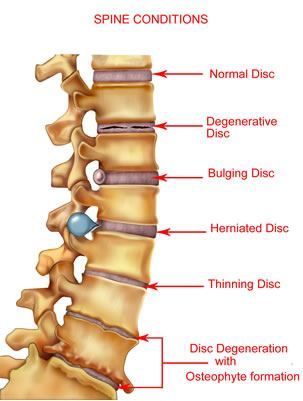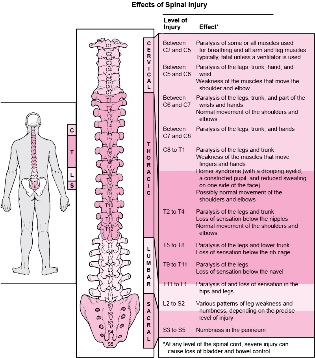
General Information
Such a disease of the human musculoskeletal system as osteochondrosis is essentially a degeneration of articular cartilage and nearby bone tissue, with frequent involvement of adjacent vessels, muscles, and nerve endings in the pathological process. IN PRINCIPLE, this term can mean a number of osteoarticular pathologies of various localization, including limb joints, but is most often used to indicate degenerative-dystrophic changes in the structure directly to the spine and, above all, the intervertebral discs.
As a result of the progression of intervertebral osteochondrosis, the human body loses its absorbing qualities, mobility and its natural elasticity. In general, this disease of the spine is very prevalent and in some degree of severity is present in most people up to the age of 40 years. Depending on the affected segment of the spine in clinical practice, osteochondrosis of the cervix, lumbar and thorax are distinguished, as well as their mixed forms, which are considered the most difficult.
Osteochondrosis of the thoracic spine, which will be discussed in this article, is the rarest form of this pathology, which, in particular, is due to the anatomical structure of the upper part of the human skeleton. Thus, in the thoracic area, the osteochondral system consists of 12 vertebrae, which are connected by rib joints, which with their anterior edges attach to a relatively monolithic sternum. Such a skeletal structure provides a sufficiently rigid and stable frame that protects the organs of the thoracic cavity (heart, lungs) from damage. In addition, the vertebrae of this segment of the spine are characterized by a small height and considerable length of spinous processes, which gives them the appearance of narrow-space plates. All this together limits the mobility of this part of the spine and the negative effect of physical activity on it, protecting the intervertebral discs from destruction.

As another reason for the lower frequency of detection of osteochondrosis of the chest in a person, compared to osteochondrosis of the lumbar and cervical, physiological kyphosis (natural curvature of the back) is in this area, due to whichmost of the external load falls on the front and side fragments of the vertebrae and discs. With the development of a pathological process in the segment of spinal movement, these areas are subject to mainly degenerative changes, however, due to the lack of nerve endings and spinal cord membranes in them, the pain is more often not noticed. However, in some cases, negative transformations in the thoracic segment of the spine affect the posterior fragments of the discs and vertebrae and / or the vertebral-coastal joints, which often leads to compression of the spinal nerve roots. In such conditions, osteochondrosis of the thoracic spine occurs with radicular syndrome, which is already accompanied by pain of various localization (sometimes very distant), as well as violations of the functionality of many organs of the human body (liver, lungs, pancreas). , heart, etc. ).
Due to such vague and varied manifestations of thoracic osteochondrosis, doctors often call this form of pathology "chameleon disease", as it can skillfully disguise itself as a symptom of respiratory and digestive diseases, the muscles ofheart, etc. In this situation, a correctly differentiated diagnosis is very important, which, through various specific studies, will help determine the symptoms and treat osteochondrosis of the thoracic spine.
The tactics and effectiveness of further therapy will depend mainly on the degree of progression of the degenerative-dystrophic process in the spinal tissues. Once you know the pathology in the initial stages of its development, it is important to improve the patient's condition is quite possible with the help of simple physiotherapy techniques and exercise therapy exercises, but in case of its late detection, you canit may be necessary to perform a complex surgical operation. This is why vertebrate doctors strongly recommend any frequent and / or prolonged back pain seek the help of a specialist.
Pathogenesis
The incidence of osteochondrosis of the thoracic spine in women and men is practically identical, since in the pathogenesis of this disease there is no gender predisposition for the onset of intervertebral disc degeneration. However, many years of clinical experience in the treatment of osteochondrosis show that its first symptoms in men appear at an earlier age than similar negative symptoms in women. In particular, this is due to the fact that osteochondralder at a certain age, the tissues of the female body are protected by the hormone estrogen, a decrease in the level of which at the time of climate transformation serves as the cause for problems with the spine.According to statistical evidence, in general, intervertebral osteochondrosis of varying degrees of severity is found in most older people, which automatically classifies it in the group of age-related diseases. Meanwhile, the latter is followed by a significant "renewal" of this pathology, until its appearance in preschool age. For this reason, it has not been possible to determine the exact etiology and initial pathogenesis of spinal osteochondrosis to date. At one time, more than a dozen theories of its origin and development were developed, including hormonal, infectious, mechanical, vascular, hereditary, allergic, and others, but in practice none of them have found complete confirmation.
sotsegments formed by two adjacent beads (upper and lower) and a disk placed between them. Paradoxically, such an overload can be the result of excessive physical work of the spine, and result in its long-term location in an unnatural position for the back. For example, prolonged work or study in a sitting position at the table is one of the main factors in the development of degenerative-dystrophic changes in the structure of the intervertebraldiskInitial formation or worsening of osteochondrosis of the thoracic spine may be affected by poor diet, uneven development of the dorsal and thoracic muscles, overweight (overweight), pathology of the lower extremities (for example, flat feet), back injuries, etc. In the pathogenesis of this disease, the disorganization of the segmental blood circulation plays an important role, which causes dehydration of the pulp (gelatinous) nucleus, which in turn leads to the loss of damping qualities of the intervertebral disc, change of loads on the ringsurrounding fibrosis and further gradual destruction of this segment of spinal movement.
In the process of its progression, thoracic osteochondrosis goes through 4 consecutive stages of development, each of which is characterized by its own anatomical and morphological changes in the structure of the disc, adjacent vertebrae and aspektitnyjet. In addition, the negative metamorphoses that occur with this disease can directly affect other nearby tissues (muscle, vascular, connective) or indirectly affect the work of distant organs and systems of the human body. (intestines, heart, lungs, etc. ).

First degree
In the initial stage of thoracic osteochondrosis formation, microcracks form in the inner membrane of the fibrous ring, into which the pulposus nucleus gradually begins to penetrate, irritating the nerve endings in the distal layers of fibrosis and in the posterior ligament. At this stage of disease development, the patient may already feel soreness directly in the middle of the back or pain apparently in the heart region. He may also be haunted by a feeling of convulsive contraction. in the dorsal muscles.
Second degree
Second-degree thoracic spine osteochondrosis is characterized by further destruction of the anus fibrosus, which is associated with spinal instability, resulting from excessive mobility of its affected vertebrae. Painfulness from the 2nd stage of pathology development intensifies and may continue as dorsalgia (persistent mild pain, aggravated by back movements) or dorsago (arising sharply against the background of a prolonged stay in one position, strongPain "shooting").Third degree
In the third period of thoracic osteochondrosis, there is a complete rupture of the fibrosus ring structure with the emergence of the nucleus pulposus beyond its boundaries and the formation of an intervertebral hernia. Most often, such formations arise in the direction of the vertebral canal, which leads to compression of the spinal cord, spinal nerves and adjacent vessels. This is associated with radicular syndrome (radiating pain in various parts of the body), thoracalgia against the background of osteochondrosis (severe pain behind the sternum, which resembles ancardiac), myelopathy (disorders of sensitivity and movement) and other symptoms of a neurovascular nature and-muskulore. Fixed thoracic kyphosis, scoliosis, or kyphosciliosis can begin at this stage.
Fourth degree
During the final stage of thoracic osteochondrosis, degenerative processes spread to the interspinous and yellow ligaments, other spinal tissues, and nearby muscles. Intervertebral disc dystrophy continues to progress, until further scarring and fibrosis. In the lunar and intervertebral joints, deforming arthrosis develops, osteophytes (bone growths) are formed in the processes of the vertebrae. The clinical picture in this period of the disease can be quite agile, as the degree of damage to individual discs is often different. In uncomplicated osteochondrosis, problematic disc fibrosis may mark the transition of the disease to the stage of stable remission, but with the loss of normal functionality to one degree or another. the spine.
Reasons
Thoracic osteochondrosis in men and women can develop due to the following predisposing factors:
- the natural process of physiological aging, accompanied by age-related changes in the structure of the cartilaginous bone tissue of the spine;
- genetic predisposition to abnormal formation of spinal movement segments;
- a physically inactive lifestyle that leads to back muscle dystrophy;
- strength sports involving excessive mechanical stress on the spine (mainly weight lifting);
- spinal cord injuries (even those that have occurred in the distant past);
- endocrine disorders in the human body, disrupting the nutrition of spinal tissues;
- significantly above normal body weight (overweight);
- unhealthy diet (lack of vitamins, minerals and fluids);
- spinal pathology with its unnatural flexion;
- imbalance in the development of the muscular framework;
- extended study or work in a sitting position with the body bent forward;
- difficult physical working conditions (constant improper lifting of weights);
- serious metabolic disorders;
- flat feet and other diseases of the lower extremities, affecting the redistribution of loads on the spine;
- vascular diseases that impair the blood supply to the back;
- severe infectious, allergic and autoimmune processes;
- frequent hypothermia;
- stressful situations and nervous exhaustion;
- bad habits and smoking.
Vertebral Syndromes
The vertebral symptoms of osteochondrosis of the thoracic segment of the spine are manifested mainly by two pain syndromes, called dorsago and dorsalgia.
Dorsago
is an acute and sudden attack of pain, the so-called "lumbago", which is localized in the intercapsular space and can occur at any time. Most often, dorsago syndrome affects patients who have been in a sitting position with the body leaning forward and drastically changing body position. At the time of the attack, patients describe it as a "dagger stroke, " accompanied by a sharp spasm of the back muscles. In addition to severe pain, subjective sensation with dorsale is expressed by shortness of breath and a marked restriction of freedom of movement in the thoracic portion of the back. A similar exacerbation of osteochondrosis with recurrent attacks can last up to two weeks.
Dorsalgia
This syndrome differs from the previous one by the gradual development of uncomfortable and painful sensations, which may increase over two or three weeks. The pain with dorsalgia itself is not so pronounced, but its prolonged presence causes a constant feeling of anxiety. The dorsal muscles, as well as the dorsal muscles, are subjected to significant stress, which can cause the patient to feel short of inhaled air. Back pain increases with trunk movements (especially when bending over), deep breathing, coughing, etc. Upper dorsalgia (main localization of negative phenomena in the cervicothoracic segment of the spine) and lower dorsalgia (main localization of negative phenomena if the thoracolumbar segment of the spine).
Extravertebral syndromes
Extravertebral syndromes of thoracic osteochondrosis, due to the greater extent of this part of the spine, can be very diverse, which greatly complicates the accurate diagnosis of the disease. They arise as a result of mechanical compression of the corresponding nerve roots, vessels near or the spinal cord itself. The symptoms of compression in men and women are generally similar and differ only when pathological impulses spread to the sexual sphere (for example, in men, on the background of the disease, erectile dysfunction is sometimes observed). In almost all cases, extravertebral symptoms are caused by already formed intervertebral hernias, which most often appear in the lower thoracic region, but in principle can form in any segment of spinal movement from vertebrae D1 to vertebrae D12. As you can see in the picture below, it is in the localization of osteochondrosis in them that the involvement in the pathological process of some systems and organs of the human body with negative manifestations characteristic of them.
Radicular syndromes
Within the framework of thoracic osteochondrosis compression symptoms, radicular syndromes are observed more frequently and clearly, provoked by compression of nerve endings in one or another segment of the spine. Depending on the concentration, such patient problems may be disturbed by the following painful phenomena:
- in case of violation in the area of the T1 vertebra - painful sensations and paresthesia from the upper part of the thoracic spine movement most often spread along the suprascapular area in the area of one of the armpits to the elbow joint;
- in case of violation in the area of vertebrae T2-T6 - soreness as intercostal neuralgia can extend from this part of the spine along the intercapsular region and surround the axillary and shoulder areas in a semicircle, as well as 2-6 spacesBetween the ribs sternum;
- in case of violation in the area of vertebrae T7-T8 - girdle pain spreads mainly from the lower level of the shoulders of the spinal joints to the upper parts of the coastal arch and affects the epigastric region, where it causes muscular defense (strong muscular tension);
- in case of violation in the region of vertebrae T9-T10 - intercostal neuralgia extends from the spinal movement segments of the lower chest to the lower parts of the coastal arch and further into the umbilical region, changing the tone of the middle sectionof the abdominal muscles;
- in case of violation in the area of vertebrae T11-T12 - the pain also originates from the spinal movement segments of the lower chest and reaches the hypogastric regions (below the stomach) and groin along the corresponding lateral areas of the chest.
In addition to pain, quite often radicular thoracic osteochondrosis syndromes are accompanied by negative symptoms from some internal organs of the abdominal cavity and / or chest. Moreover, in some cases, such symptoms are so similar to the pathological manifestations of other diseases that it is practically impossible to accurately know their affiliation without directed research. For example, the medical literature describes a case of unwarranted conduct pendectomy (surgical intervention to remove the appendix) according to the unclear clinic of acute appendicitis, which in fact turned out to be one of the pronounced osteochondrosis syndromes.
Thus, when the osteochondrotic process is localized in the upper thoracic region of the spine (from T1 to T4), patients may experience various irritations and / or disturbances in the esophagus or pharynx, which are often perceived as the presence of a foreign body. . Such sensations are often paroxysmal (sometimes constant) and intensify with a serious load on the problematic part of the back. Sometimes the manifestations of radicular syndrome in the upper chest segment are confused with obstructive bronchitis or pneumonia, as a reflex cough with osteochondrosis of the thoracic region and chest pain resembles the symptoms of this group of diseases. Also, chest pain can occur in the form of thoracic pain, to remind its intensity is an attack of angina pectoris, pulmonary thromboembolism, myocardial infarction and other pathologies similar to a serious nature, which requires a detailed differential analysis by doctors.
Patients with osteochondrosis in the middle thoracic spine (T5 to T7) most often experience discomfort and pain in the solar plexus and stomach, which are called vertebrogenic gastralgia. In the defects of the spinal movement T8-T9, it is possible to develop pain in the region of the duodenum, called - vertebrogenic duodenalgia. . . Both those and other painful sensations in different patients or at different times can vary in intensity from mild and "painful" to extremely acute. They intensify, as a rule, with a prolonged posture of the body in one position (sitting on a table, lying on his back, etc. ), in case of sudden body movements, and also at the moment of sneezing or coughing. Often these pains are accompanied by paresthesia. (numbness, tingling, burning) in the middle of the abdominal wall.With radicular manifestations of osteochondrosis in the lower thoracic region of the spine (from T8 to T12), some patients may complain of pain in the lower abdominal cavity, mimicking intestinal disorders or pathology. Sometimes the bitterness spreads to the gallbladder and is localized to the posterior region of the right hypochondrium. Even more rarely, patients experience pain in the suprapubic region similar to the bladder pathology clinic. As before, the nature of such pain can vary in a fairly wide range (from mild to intense), and their severity increases with prolonged physical or static stress on the back, sneezing, coughing, etc.
Compression myelopathy
This compression syndrome of thoracic osteochondrosis is quite rare and is a compression of the spinal cord directly from the resulting intervertebral hernia. . . Its characteristic symptoms at the beginning of the formation are expressed with local pain in the relevant area of back or girdle pain in the problem area, as well as a feeling of weakness and / or numbness in the legs. With progression, the pain intensifies, may affect the downstream intercostal space, abdominal organs, groin area, and is noticeably felt in the lower extremities. In severe cases against the background of myelopathy compression dysfunction of the pelvic organs may develop, leading to disruption of the processes of defecation and / or urination. In addition, there may be severe superficial and deep paresthesias and sensory disturbances, up to spasticity in one or both legs.
Vascular compression
Compression of the vessels adjacent to the thoracic segment of the spine leads to myeloidemia, as a result of which the blood supply is interrupted, and thus proper nutrition of the spinal cord. The manifestations of this syndrome are actually complete recurrence of the symptoms of compression myelopathy and are characterized mainly by pelvic disorders as well as loss of sensation in the lower limbs and decrease in their functionality. Patients often describe this problem with the phrase - "feet fail".
Vegetative syndromes
In a number of cases, with thoracic osteochondrosis, the vegetative nerve nodes (ganglia) are damaged, as a result of which the patient may experience a variety of negative symptoms. These can be different paresthesias. , itching and changes in skin pigmentation in the problematic ganglion area, burning sensation of half of the body, local temperature disorders, hyper- or muscle loss, disorganization in the work of limbs or internal organs, etc. According to him, these visceral vertebrogenic symptoms are similar to the manifestations of radicular syndromes, but differ from them in the absence of clear localization and the presence of disorders of secretion and movement. When involved in the pathological process of a star joint that affects the upper thoracic vertebrae, there may be violations in the arms, upper chest, and heart. In case of damage to the inferior thoracic ganglia, functional disorders can occur in the pelvic organs, abdominal and chest cavity, as well as trophic changes in the lower extremities and the rest of the body.



































